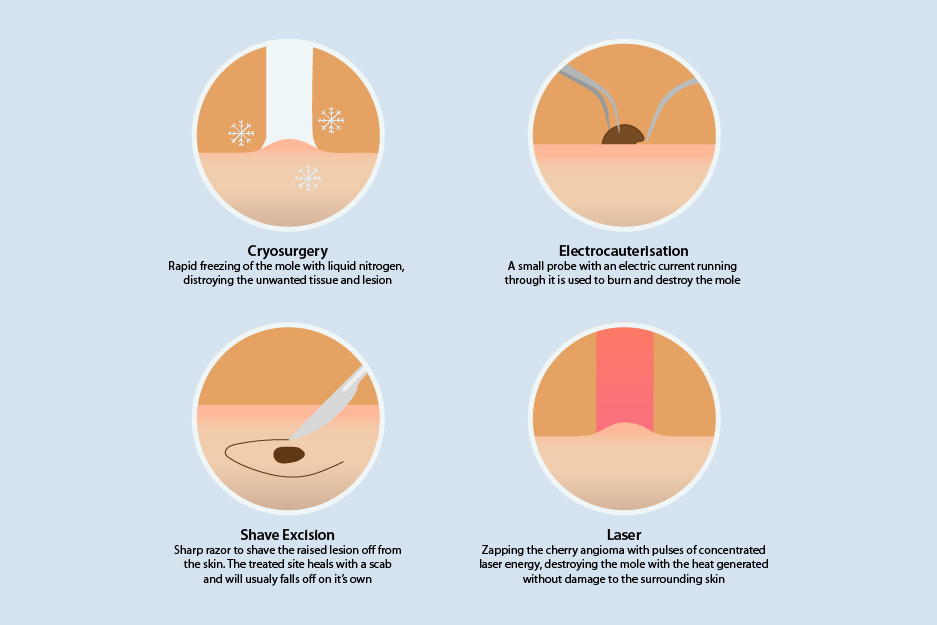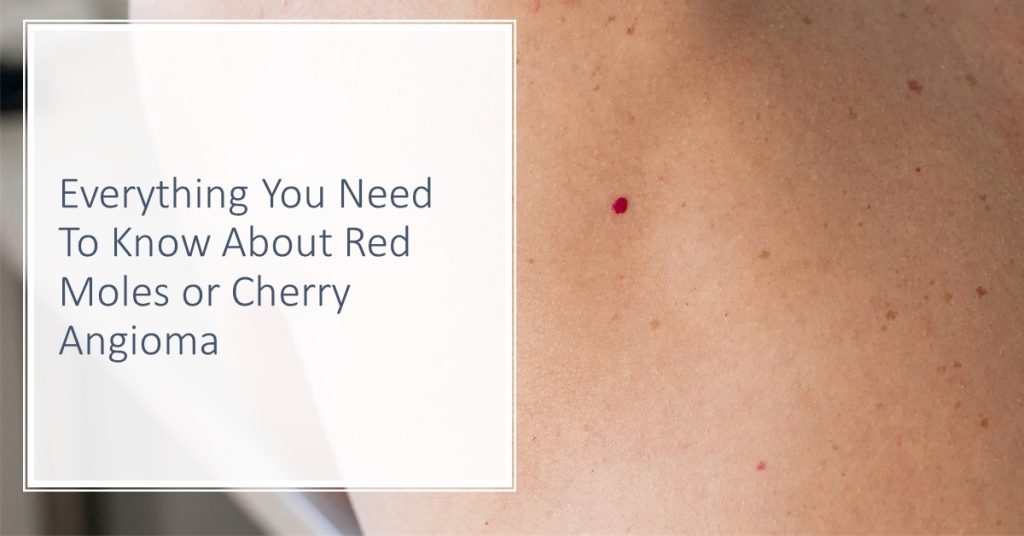Many people experience unsightly skin growths appearing on different parts of their bodies. These include everything from whiteheads or blackheads to moles that can have different colors. There’s a certain type of moles, however, that often cause a bit of a concern due to their sudden appearance, bright color, and rapid growth – the red moles or cherry angioma.
These red bumps can be round or oval in shape and aren’t harmful. But they are definitely not good to look at and mar one’s natural beauty. Furthermore, scratching, rubbing, or cutting them open often results in bleeding.
If you’re considering mole removal Singapore, it’s essential to consult with a qualified dermatologist to discuss the best treatment options.
Want to know more about cherry angiomas, their causes, and treatment? Here’s everything you need to know about them.
What Are Red Moles?
Red moles or cherry angiomas are common skin growths that are benign (non-cancerous) in nature. Generally, these skin growths develop in people 30 years or older. They can develop on any part of the body and don’t usually need treatment. Most often, they appear on the arms or trunk. In rare cases, however, people develop cherry angiomas on their faces, hands, and feet. Their reddish appearance is due to the tiny blood vessels inside them.
Generally, such skin growth shouldn’t raise any health concerns unless it starts bleeding too often or its shape, size, or color changes. If any bleeding is noticed or the appearance of the red moles changes, one should consult their doctor.
How Do They Look Like?

Cherry angiomas are small red bumps with an oval or circular shape. They can have a diameter of up to one-fourth of an inch. Some red moles are even with the skin and smooth to touch, while others may have a slightly raised appearance. Rubbing or scratching them can cause bleeding.
What Causes Cherry Angioma?
The exact cause of cherry angiomas appearing on the body is yet to be discovered. However, they may appear due to one of the three potential reasons.
1. Genetic Component: Sometimes, it is a genetic component. In that case, several members of the family will have this condition.
2. Aging: Aging is another possible reason for cherry angiomas forming and appearing on different parts of the body. They often start popping up once a person reaches 30 years of age. It is likely for them to grow bigger and increase in number as the years pass by.
3. Pregnancy: Pregnancy could also be the underlying cause of cherry angiomas appearing on the skin. They may disappear after pregnancy for some people, but that doesn’t happen in all cases.
Besides these more prevalent causes, red moles may also be caused by chemical exposure, climate, and some medical conditions. Regardless of their cause, however, experts have discovered that the formation of cherry angiomas is due to the dilation of small superficial blood vessels or venules. This dilation of venules causes them to swell up and become red. Once the venules break, they appear on the skin, forming a cherry angioma.
Where Does Cherry Angioma Usually Appear?
Cherry angioma can appear literally anywhere on the body. However, in most cases, they appear on the shoulders, arms, torso, and legs.
Are Red Moles Harmful?
Red moles or cherry angiomas are nothing more than a bunch of overgrown blood vessels. They are considered entirely harmless.
However, if they start changing or bleeding too often, one should definitely consult their doctor as a preventive measure to avoid serious health issues.
Is Cherry Angioma Preventable?
As the underlying cause of cherry angiomas is not yet known, no single prevention tip could help prevent them completely. However, experts recommend that one should avoid certain chemicals or treatments to prevent cherry angiomas. These include topical nitrogen mustard, butoxyethanol, and bromides.
How To Get Rid of Red Moles?
While treatment for cherry angiomas is not needed in most cases, there are mole removal options available to get rid of them for cosmetic purposes. Sometimes, removing red moles becomes important because they appear in an area that easily gets bumped, resulting in regular bleeding.
In Singapore, several treatment options are available for mole removal. The choice of mole removal technique depends on the number of moles and their sizes. It helps determine the best treatment option for the patient.
Depending on the factors above, the doctor may suggest one of the following treatments to get rid of red moles.

1. Cryosurgery
Cryosurgery involves the use of liquid nitrogen for freezing the cherry angioma. It freezes the angioma, and the unwanted tissue is destroyed by the extreme cold produced in the process. The procedure is relatively short and easy and causes some discomfort.
Usually, a single treatment session of cryosurgery is enough for removing the red moles. During the procedure, the doctor sprays liquid nitrogen on the angioma for around 10 seconds. Not much care is needed for the wound afterward.
2. Electrocauterisation
Electrocauterisation or electrocautery is a procedure used for removing unsightly or unwanted skin tissue. It can also seal blood vessels by burning them. The surgical procedure can also be used for burning the skin angiomas.
During the procedure, the moles are burned by delivering an electric current through a tiny probe. A grounding pad is also placed on the patient’s body so that the rest of the body is grounded from an electrical surge.
3. Shave Excision
Shave excision uses a sharp razor or a scalpel to shave down the mole. The angioma is removed from the top part of the skin, and no stitches or sutures are required after its removal. Typically, the procedure causes minimal scarring.
The treatment results in a small wound that heals easily using a superficial, temporary scab. The scab usually falls off in a couple of weeks and a smooth skin surface is revealed.
4. Laser
Laser treatment is one of the most common methods for removing red moles for cosmetic reasons. However, this technique for mole removal is inappropriate for removing larger moles or ones with deep roots.
The procedure involves use of a pulsed dye laser for removing cherry angiomas. This concentrated yellow laser produces enough heat for destroying the lesion. The procedure usually take less than 30mins and can be performed as an outpatient treatment.
Depending on the number of angiomas, patients usually need 1-3 treatment sessions to get rid of the moles. Laser treatment may result in slight bruising, and it can last for up to 10 days.
Consult A Professional For Your Treatment

Red moles are usually harmless and don’t need treatment, unless it is for cosmetic purposes. However, one should schedule an appointment with their doctor if they notice the appearance of red moles is changing. It is important to get any skin growth or lesion examined if it changes its appearance over time. After examination and some tests, the doctor can rule out the likelihood of any serious health conditions, like skin cancer.
The doctor may recommend a biopsy for further examination of the lesion. It can involve the removal of the entire lesion or just a small part of the angioma for diagnosis of other conditions or to rule them out.
Final Thoughts
Red moles or cherry angiomas are benign skin growths that may appear on any part of the body, and they are more prevalent in people 30 years of age or older. They are generally harmless and don’t need any treatment. However, one may choose to get rid of cherry angiomas for cosmetic reasons.
Several treatment options are available to get rid of cherry angiomas, whether for cosmetic purposes or medical concerns. The choice of treatment technique usually depends on the number and size of the angiomas.
One should consult their doctor if the red moles start changing in shape, size, or color. Sometimes, they may also start bleeding too often. Whatever the case, seek help from a dermatologist or certified doctor. They will advise accordingly after examination if necessary for biopsy of a small part of the skin growth or the entire angioma to diagnose or rule out the likelihood of serious health conditions.
FAQ
Why do I suddenly have red moles?
Red moles appear due to overgrowing vascular cells just under the epidermis layer of the skin. While researchers are not completely sure of the underlying cause of such vascular growths, some evidence suggests it is caused by genetic predisposition.
Are red moles concerning?
Skin marks and moles are often natural. Similarly, red moles or cherry angiomas usually aren’t something to be worried about. However, they may still be a cosmetic concern and people often choose to see a dermatologist and get these skin growths removed. In addition, they may become a medical concern if their shape, size, or color changes over time.
Can a cherry angioma be cancerous?
Generally, cherry angiomas are benign (non-cancerous) skin growths and rarely cause any serious health concerns. However, if a person notices any change in their appearance, they should talk to their doctor for further diagnosis.







